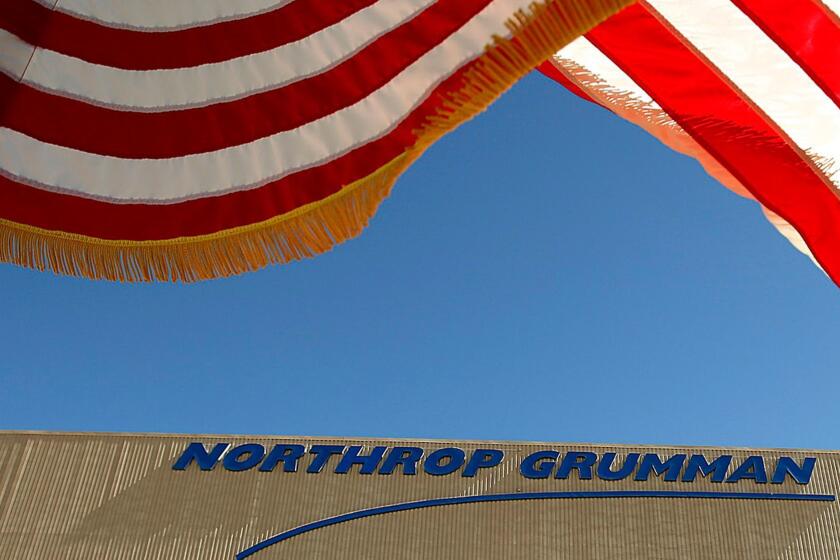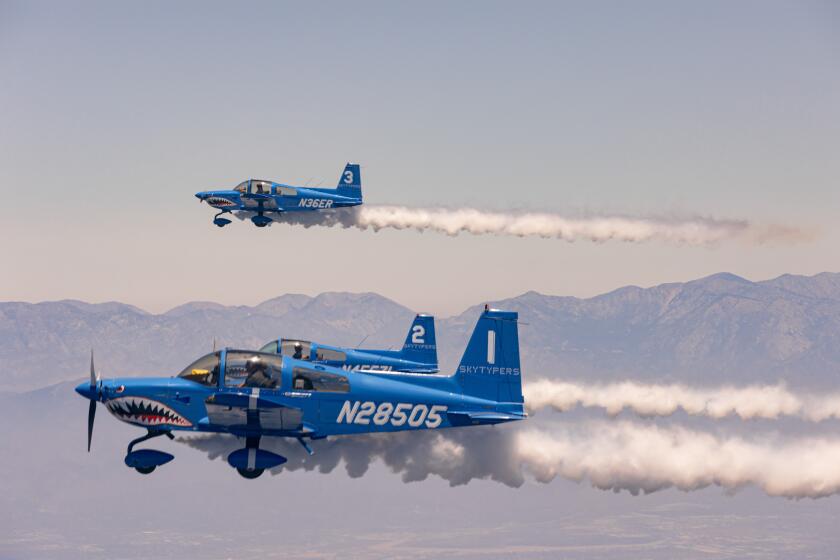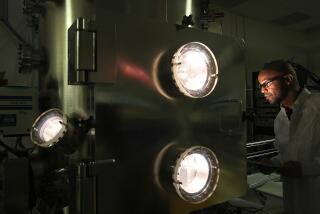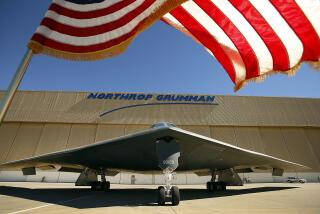Northrop Grumman debuts new B-21 bomber as aerospace employment rebounds
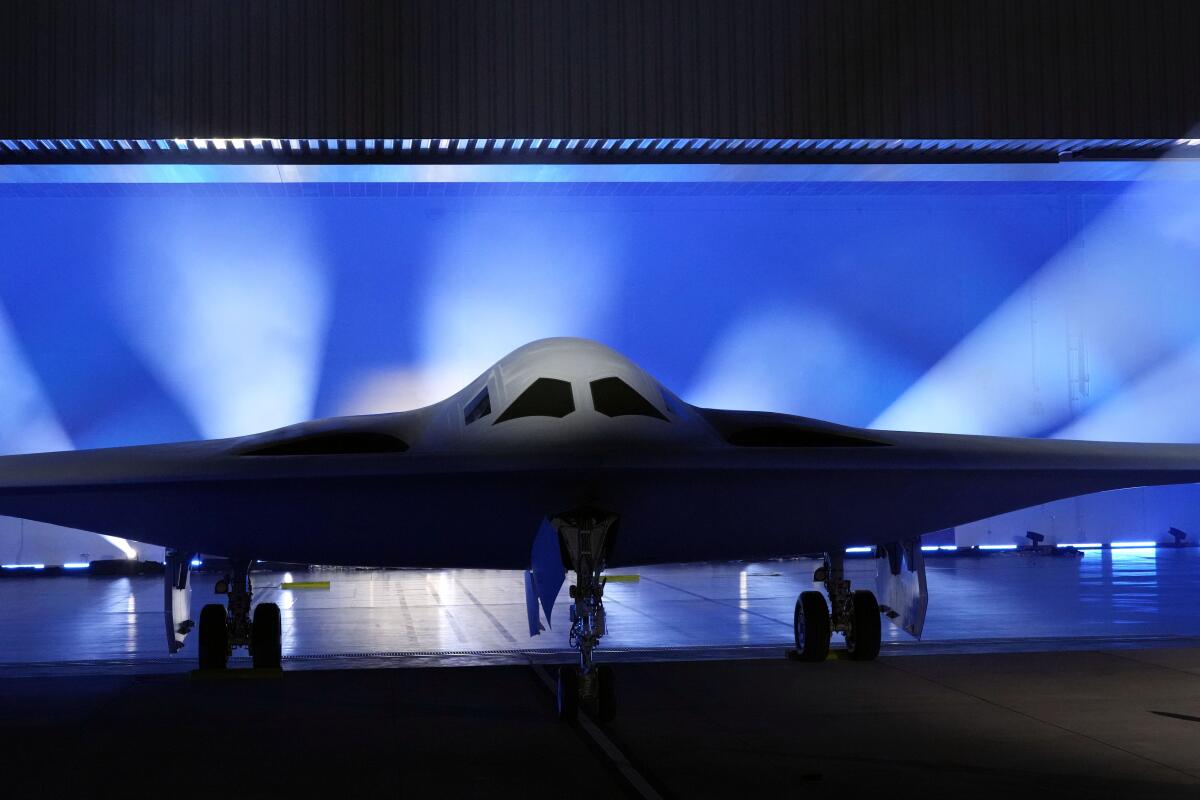
Seven years after Northrop Grumman Corp. won the contract to build a new stealth bomber, the B-21 Raider was unveiled Friday evening in a dramatic ceremony at dusk.
A giant silver sheet was hoisted off the aircraft as it was slowly towed out of its hangar at Northrop Grumman’s Palmdale facility. The bomber has a flying-wing shape with a massive wingspan that measures nearly as wide as its hangar. Ceremony attendees, a group that included industry executives, U.S. Air Force officials and personnel and Northrop Grumman employees, could largely see only a front view of the plane.
“The B-21 looks imposing but what’s under the frame and space-age coating is even more impressive,” Defense Secretary Lloyd J. Austin III said during the roll-out ceremony. “Fifty years of advances in low-observable tech has gone into this aircraft. The B-21’s edge will last for decades to come.”
The Air Force plans to buy at least 100 new stealth bombers by the mid-2030s for about $80 billion. Already, six B-21 bombers are in the final assembly and test process in Palmdale, Northrop Grumman said.
Designed to fly long-range missions while evading radar detection, the plane is expected to make its first flight next year, and the Air Force plans to get its first few B-21 bombers by the mid-2020s.
The assembly line represents a boost to Southern California’s flagging aerospace industry, which has declined from the heights reached during World War II, the space race and the Cold War. In recent years, Southern California’s aerospace resurgence has largely come from the commercial space sector, with the growth of Hawthorne-based SpaceX and various drone makers playing a large role.
But the region’s aircraft and defense contractor roots are still very much alive.
“The U.S. military is still choosing to build these very big, complicated bombers and other weapon platforms,” said Peter Westwick, a professor in USC’s history department and author of “Stealth: The Secret Contest to Invent Invisible Aircraft.” “As long as the U.S. military wants to build those, a lot of the expertise for that still resides in Southern California.”
Once seen as the region’s lifeblood, the aerospace industry accounted for just 2% of Los Angeles County’s total employment in 2019, according to a 2020 L.A. County Economic Development Corp. report. That year, more than 55,000 people were employed in aerospace and defense, a slight uptick compared with previous years.
In the Antelope Valley, where defense contractors have advertised open jobs on billboards, Northrop Grumman is the largest private employer.
Employment at Northrop Grumman’s Antelope Valley sites has soared to more than 7,000 workers, double the population in 2015 when the company first won the bomber contract.
Antelope Valley is a major hub for aerospace activity. It’s home to the sprawling and secretive Air Force Plant 42, which houses facilities used by Lockheed Martin, Boeing and NASA, in addition to Northrop Grumman’s B-21 assembly line. About 16,000 people work at the complex, said Thomas Lynch, communication and public information officer for the city of Palmdale.
Romance, corporate promotions, culture wars — Donald Trump, for and against — play out above our heads as skywriting and other aerial advertising boom.
“These are high-paying industry jobs, even if they’re not as numerous as they used to be,” said Robert Kleinhenz, principal economist with Kleinhenz Economics and director of research at Cal State Long Beach’s office of economic research. “This is an important part of the economy. The fact that that activity is taking place here has huge spillover effects on the rest of the economy.”
There’s history at the plant. Northrop Grumman also built the B-2 stealth bomber there, and the company has leveraged that experience into the B-2’s successor, the B-21. A few hundred people who worked on the B-2, as well as B-2 pilots, have contributed knowledge to the B-21 and conveyed to co-workers what that experience was like, said Doug Young, vice president and general manager of the company’s strike division in the aeronautics systems sector.
Young knows the B-2 well. He started working on the bomber for Northrop in 1985 and stayed with the program for 10 years.

A lot has changed since the B-2 first rolled out. For one, stealth technology has improved, the company says, although it’s understandably reluctant to offer details. The B-21 will also be more supportable and maintainable than its predecessor, a major point of emphasis for development given the high maintenance costs for the B-2.
SpaceX reveals capsule’s secret payload: Cheese
Northrop Grumman iterated on thousands of designs for the bomber and tested aspects digitally before building hardware, Chief Executive Kathy Warden told reporters shortly before the roll-out ceremony. This digital approach helped “de-risk” the test program, said Gen. Charles Brown Jr., Air Force chief of staff.
Compared with the B-2, the B-21 will better adapt to and incorporate different payloads and capabilities, according to Northrop Grumman officials. That means the bomber could one day carry weapons that have yet to be invented, Austin said at the ceremony.
“Twenty years ago, if you bought a computer, it was a really challenging thing to integrate a printer or a modem,” Young said. “These days, you just bring stuff home, and it’s plug-and-play. Aircraft today are much more adaptable.”
The manufacturing site itself has also changed. Once used only for B-2 work, Northrop Grumman’s Palmdale facility now also produces the center fuselages for the F-35 fighter jet, the RQ-4 Global Hawk drone and the MQ-4C Triton drone.
That variety is intended to keep and maintain the workforce, even after programs end.
“In the past, in the Antelope Valley, programs were episodic,” Young said. “They would happen, and they would go away.”
Although the program has relied on veteran aerospace workers and those from other manufacturing industries, a large portion of workers are in their first aerospace job or first job ever, said Tom Jones, Northrop Grumman Aeronautics System president.
“This is the beginning of a multidecade franchise in the Antelope Valley,” he said. “The Northrop Grumman aeronautics workforce of the future is being created today through this program.”
